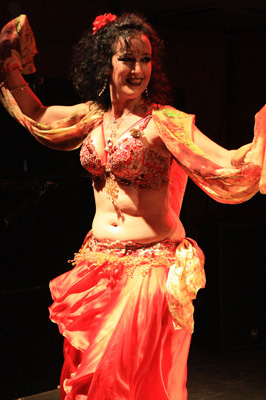There's a Middle Eastern saying that if you spend 40 days in a place, you become part of its people. And that's what international belly dance superstar Tamalyn Dallal decided to do: spend 40 days in five regions to learn their special moves and music of the ancient dance.
For international belly dance superstar Tamalyn Dallal, "dancing is my life." Different from other traditional belly dancers, Dallal dances with every muscle and integrates various kinds of ethnic dances in her performance.
The Xinjiang Uygur Autonomous Region of China was one of her stops described in her book, music CD and documentary: 40 Days and 1,001 Nights.
"There are ups and downs in the trip. In some places like the Xinjiang region of China, there are just so many things to see and to learn. I even convinced myself to try the local medicine and learned a little about the history," says Dallal, an American living in Miami Beach, Florida, when she isn't traveling.
Dallal is a famed performer, teacher and choreographer, invited to teach and perform at Shanghai's belly dance school, the Isis Club, this month.
She told Shanghai Daily that she had learned "Xinjiang style of dance and loved it," so she decided to visit China's northwestern region, which is part of Central Asia, to learn more about the culture.
She also visited Egypt, Indonesia, Jordan, and the island of Zanzibar in Tanzania, East Africa.
The 48-year-old dancer chose the number 40 because of its ancient significance - ancient astronomers measured the solar year in 40-day cycles.
She cited a Middle Eastern saying: "if you spend 40 days in a place, you become part of its people."
And the number 1,001 is straight from the legendary tales of the Arabian Nights, also known as One Thousand and One Nights in which Shahrazad tells a story every night.
Falling in love with belly dancing from the beautiful Middle Eastern music she collected as a child, Dallal started her dancing career when she was 17, back in 1976.
She said the dance was not popular at all at that time and she danced mostly at weddings in the early years.
"Later, it got associated with stripping and clubs. Fortunately, people are more educated about the dance now and many consider it a form of art," explains Dallal.
Belly dance, sometimes called Oriental dance, is an ancient dance said to originate from fertility cults. The movements of the abdomen and pelvis are said to be like those practiced by groups of women in preparation for childbirth.
Dallal has danced for the rich and famous and written about it (Belly Laughs). She is also the author of Belly Dancing for Fitness: The Ultimate Dance Workout that Unleashes Your Creative Spirit.
She is a choreographer and producer of theatrical performances.
Having taught and danced for more than 30 years, Dallal is not only passionate about the movements and the music, but also fascinated by the culture that gave rise to belly dancing. This inspired her trip in 2005.
Dallal picked Indonesia for the mixture of its culture, Egypt's Sia Oasis because "it is a must-go for belly dancers," Zanzibar for "the uniquely beautiful music," Jordan because it was "on top of the travel list," and China's Xinjiang Uygur Autonomous Region because she fell in love with Xinjiang-style dance.
At each place, Dallal tried to learn something uniquely ethnic, the dances, songs and customs. She also spent as much time as possible with the locals, without translators.
In some places, such as Jordan, "it could be very quiet and boring at first. But everything is hidden under the surface, I just had to dig them out. It has been a very exciting trip."
She concluded the trip in October 2006 and wanted to record her experiences.
In addition to the book, Dallal also produced a documentary. Moreover, she also released a music CD she produced in Zanzibar, with Africa's oldest band, Ikhwani Saffa, founded in 1905.
Dallal says her travel experience also influences her dances in many ways. In a typical belly dancing show, body movements are small, while the focus is on the belly and hips.
However, Dallal dances with every muscle and integrates various kinds of ethnic dances in her performance.
In particular, the dance that attracted her to Zanzibar involves all kinds of expressive movements of the arms and upper body.
"Dancing is my life and I love teaching it," she says. "I love belly dancing because it makes women more feminine, expressive and creative. It is extremely difficult to be womanly in today's world, since women have to compete against men in all fields."
Having taught in 34 countries and regions with many Asian students, Dallal considers Asian dancers "diligent and graceful" and dismisses the stereotype of inhibited, restrained Asian women.
"Asian dancers have very nice hands for making graceful gestures. They are feminine and serious about learning."
(Shanghai Daily October 15, 2007)


